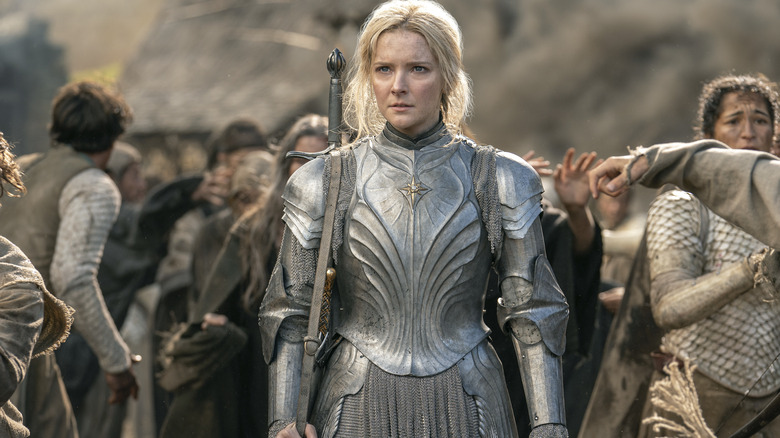
Major spoilers for the first two episodes of "The Lord of the Rings: The Rings of Power" follow!
Twenty years after the Peter Jackson trilogy changed the entire face of pop culture and blockbuster filmmaking as we know it, "The Lord of the Rings" is back to prove that author J.R.R. Tolkien's epic material still has a place in our ongoing fantasy lexicon. After months and months of cautious optimism turning into outright hype, "The Lord of the Rings: The Rings of Power" has finally arrived to tell its giant-sized story on the small screen. Though set thousands of years before Frodo or Aragorn or the rest of the Fellowship ever set foot on Middle-earth and in an entirely separate continuity altogether, the Prime Video series still features a few recognizable names, some intriguingly familiar locations, and one particular big bad whose reputation will certainly stand out to anyone who ever watched the original trilogy.
Fittingly enough, Tolkien's dense storytelling has been translated to an equally as dense live-action series that throws characters, references, and even quite a few Easter eggs at audiences in rapid succession -- catnip for the most hardcore viewers, to be sure, but potentially an overwhelming experience for all those tuning in with little frame of reference other than the movies.
But don't let that turn you away! Luckily, we've taken many of the absolute nerdiest details, deep cuts or otherwise, and condensed them into one easy-to-follow guide aimed at both invested fans and casual viewers alike. Middle-earth is back and as rich and vibrant as ever, so let's go on another adventure.
Past Is Prologue
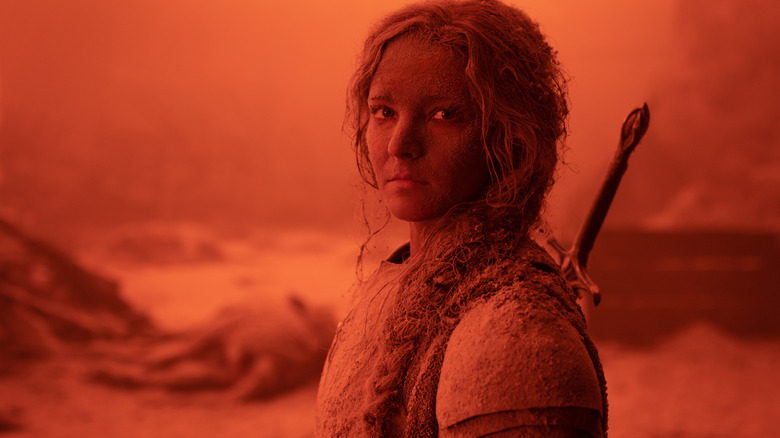
The wistful, magical voice of the elf Galadriel gently washes through viewers and narrates significant events and backstories necessary to understand the following events. This exposition-heavy prologue immediately establishes the broad strokes of the story, setting up the main themes, the tone, and the overarching conflicts that will echo from the distant past into the present day. We learn about a manipulative Dark Lord, a devastating and immensely costly war, and the fallibility of characters in thinking that evil is gone for good ... even though it may only be sleeping.
Does any of this sound oddly familiar? It should, because the opening 10 minutes or so of "The Rings of Power" essentially recreates the famous prologue of Peter Jackson's "The Lord of the Rings: The Fellowship of the Ring." Instead of Cate Blanchett's wise and even-keeled Galadriel, we now have Morfydd Clark's younger and more reckless take on the same character to guide us through the early stages of this brand-new story. Though not technically the exact same character as Blanchett's version, the parallels and similarities between how these two Middle-earth tales kick things off are simply too uncanny to ignore — and likely too similar to chalk up to mere coincidence.
If it worked once, introducing a generation of even more skeptical viewers in the early 2000s to the wonders of Tolkien, then why not try it again here? It's difficult to argue with the results, as we once again found ourselves falling headfirst into a classic story of good vs evil, with all the comforting trappings we've come to expect from "The Lord of the Rings."
Bird's The Word
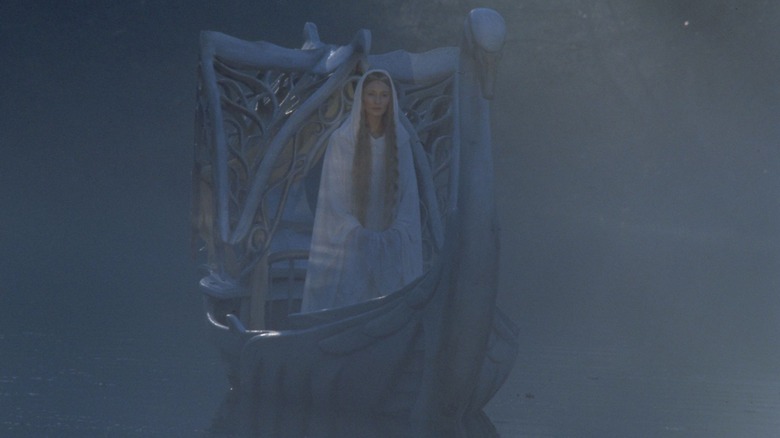
Okay, I did warn you we were going to get nerdy here, right? The very first scene in that aforementioned prologue of "The Rings of Power" might seem unassuming enough, showing us Galadriel as a child in the carefree and innocent realm of Valinor, essentially the elven equivalent of heaven. Almost immediately, however, we see that even elvish kids can be just as obnoxious as any regular human one. All Galadriel wants to do is sail her little makeshift boat down a river, but her rude friends can't help but spoil the fun with some rocks. This leads to a touching conversation between herself and her unnamed older brother, setting up the arc we see the older Galadriel embark upon in the following hour. But don't overlook one tiny little detail from that scene.
The real eye-catching aspect comes from the shape of that doomed sailboat, which resembles a graceful swan when fully unfurled. This by itself wouldn't seem very notable, but it does hearken back to a memorable moment involving a much, much older Galadriel that lends a neat sense of synchronicity between altogether different mediums. In "The Fellowship of the Ring," the eponymous Fellowship meets Galadriel in her paradise home of Lothlórien, where they rest to recover their strength in the aftermath of losing the wizard Gandalf. When it comes time to part company, Tolkien describes Galadriel sailing towards them aboard a magnificent swan ship of incredible craftsmanship.
If you take her introductory scene in "The Rings of Power" into consideration, that later moment in "Fellowship" suddenly feels infinitely more symbolic and meaningful. Even thousands of years later, perhaps Galadriel still keeps a reminder of the tough life lesson she learned from her childhood swan ship. The power of storytelling, folks!
Completing The Circle
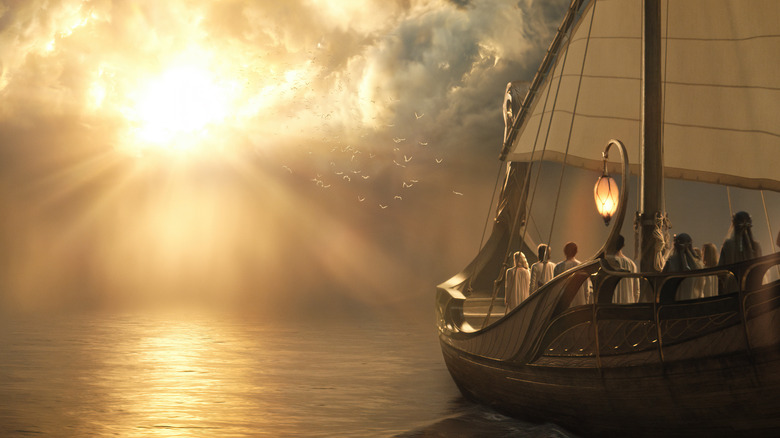
To keep with the Galadriel-centric theme in the early going, much of her arc in the premiere episode centers on her duty to her King Gil-galad (Benjamin Walker) and her duty to her late brother, killed while fighting Sauron's destructive armies. As a reward for her service, she and all the soldiers under her command are sent to the Undying Lands of Valinor, a journey that takes them west of Middle-earth. Setting sail from the Grey Havens, they embark on a voyage through the Sundering Seas to the mystical land of never-ending "winterless spring." Perceived as an invaluable gift to all other elves, Galadriel doesn't quite see it the same way — not while her brother's death and her unfinished vendetta against Sauron has left so much darkness in her heart.
The biggest character-defining moment comes when she rejects this path and turns away from paradise, watching as the gateway to Valinor shuts ... seemingly forever. Those who know their Tolkien lore (or, you know, just happened to watch the final few minutes of "The Return of the King," of course) know that this isn't quite the case. Once Frodo destroys the One Ring — and, by extension, all influence Sauron could ever hope to wield — Galadriel is finally free to depart the mortal lands of Middle-earth and retire to Valinor with the rest of her kin. Essentially, the voyage to Valinor that she embarks on in "The Rings of Power" is the end of the journey we see Frodo, Bilbo, Galadriel, and Gandalf begin in the heartbreaking penultimate scene of "The Return of the King."
Once again, despite taking place in a separate continuity, here's another moment that retroactively adds even more meaning to the future actions we know Galadriel will eventually take.
Humans And Elves, Mass Hysteria!
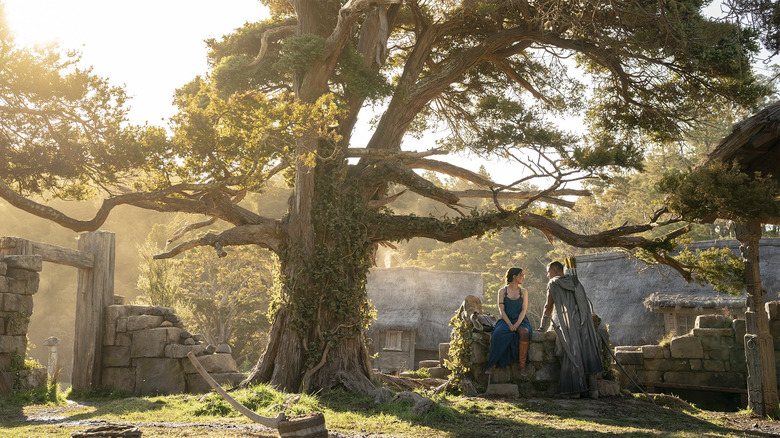
We've focused thus far on one of the most recognizable characters in Tolkien's legendarium, but what about a wholly original hero created specifically for "The Rings of Power" series? Ismael Cruz Córdova's Arondir plays a key role in the first and second episodes, as part of a dwindling elven guard tasked with keeping vigilant watch over the Southlander humans who once allied themselves with the evil Morgoth, who was vanquished before the events of the series but whose deeds still cast a pall over those under his sway. Both episodes hammer home the idea of mistrust between different races and the idea that petty divisions will inevitably lead to our downfall. Elves are regarded with immediate suspicion by humans, dwarves and elves tend to retreat to their own corners, and Harfoots stay out of the business of big folk altogether. Here's where Arondir and the human Bronwyn (Nazanin Boniadi) come in.
After breaking the rules to pay his admirer a visit, Arondir has to suffer the reproaches of a fellow elf who warns him that such unions, historically, have never turned out well. He vaguely alludes to two other instances of humans becoming intimate with elves, citing both as ending in tragedy. Obviously, Aragorn and Arwen's love affair hasn't yet happened, but this subplot can't help but bring up memories of their bittersweet romance — as an immortal being, Arwen must renounce her own immortality (ironically, by also rejecting the call to sail away to Valinor) and instead live as a mortal woman with Aragorn. But the most famous instance of this in Tolkien's world goes back to Beren and Lúthien, an epic tragedy told in full in "The Silmarillion."
Perhaps Arondir and Bronwyn will end differently, providing some hope amid the darkness.
Fëanor And The Silmarils
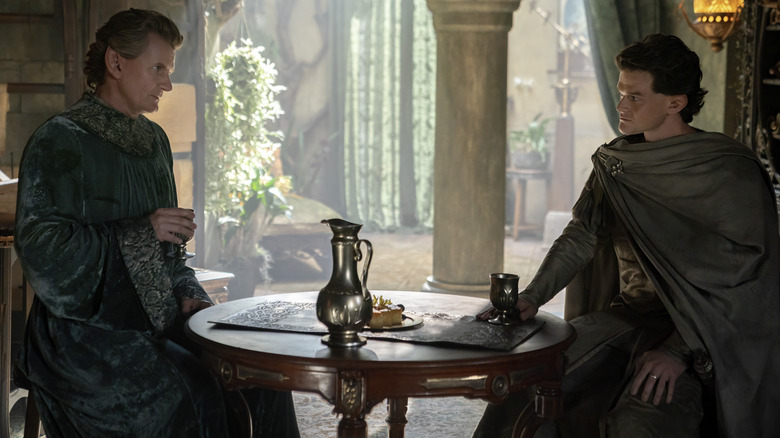
A key aspect of any fantasy story has to do with its world-building, implying an entire lived-in sense of history that far precedes the events of a particular story. Set in the Second Age of Middle-earth, "The Rings of Power" goes back the farthest we've ever seen of this world in live action ... but an entire age still took place even before this story, as well. Leave it to a linguist and academic like Tolkien to invent some of the most complicated and sprawling fictional history of any fantasy story! One of the most pressing examples of this in the Prime Video series revolves around the conflict with Morgoth, his sinister act of destroying the light-giving trees of Valinor (both of which were glimpsed in that opening scene), and his obsessive quest to find and steal the impossibly beautiful jewels containing the very last of that light -- the Silmarils.
The elves Elrond and Celebrimbor (Charles Edwards) briefly mention this history during an early scene in episode 2, admiring the hammer used to make those jewels in the first place and musing on how much beauty and destruction that such an act eventually wrought on Middle-earth. Fëanor earned his place in the (fictional) history books as the elven king of old who crafted the Silmarils in the first place, but couldn't overcome his own greed and selfishness which inadvertently led to even more death and suffering.
For our purposes here, the fact that such a complicated figure would be a source of inspiration for Celebrimbor — the eventual forger of the Rings of Power — should serve as an early warning sign as to the dangers of unchecked ambition.
Khazad-dûm
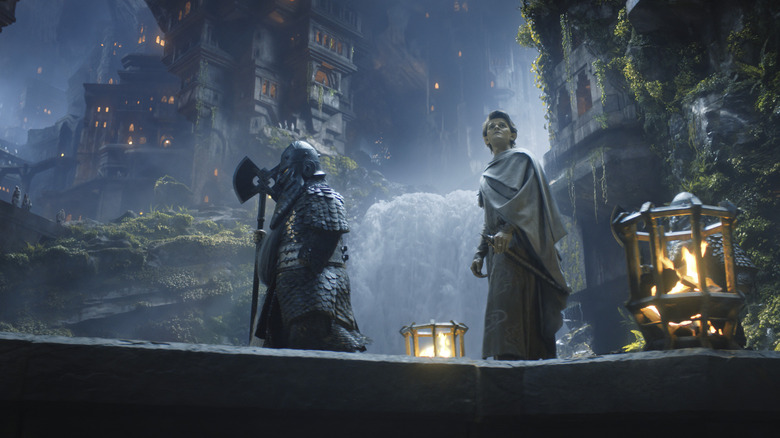
Remember what I was saying earlier about familiar locales popping up again in "The Rings of Power"? Well, one major setting that we've most definitely seen before is represented by the great realm of Khazad-dûm, a remarkable feat of engineering that speaks to the uniquely dwarven talent for mining. Episode 2 brings Elrond and Celebrimbor to its stony gate, begging an audience with Prince Durin in order to join forces and help create the imposing forge that Celebrimbor is set on building. When Elrond is brought inside, the breathtaking waterfalls, the massive mirrors reflecting the sun and lighting up the caverns, and the carved buildings all supersede anything the outsider elf has ever seen before.
Though only ever referred to by its formal title here, Khazad-dûm has a very different name during the Third Age: the Mines of Moria, which the Fellowship enters and leads to Gandalf's death centuries later. Seen at the peak of its power in "The Rings of Power," Khazad-dûm eventually brings about the ruin of Durin's line and serves as another cautionary tale of greed awakening even greater evils. Here, however, the thriving community still flourishes underground and hosts a kingdom of diverse dwarves. Good things never quite last forever in Tolkien's Middle-earth, but that only makes the scenes between Elrond, Prince Durin, and Princess Disa (Sophia Nomvete) even more of a delight.
Elrond wistfully mentions that "Where there is love, it is never truly dark," in reference to the home Durin and Disa have made together. When he eventually sends the Fellowship to destroy the One Ring, even he couldn't have foreseen just how different the Khazad-dûm they visit would be.
New episodes of "The Lord of the Rings: The Rings of Power" air on Prime Video every Friday.
Read this next: The 14 Best Sci-Fi Shows On Amazon Prime
The post The Best Easter Eggs in The Lord of the Rings: The Rings of Power Episodes 1 and 2 appeared first on /Film.
0 Commentaires